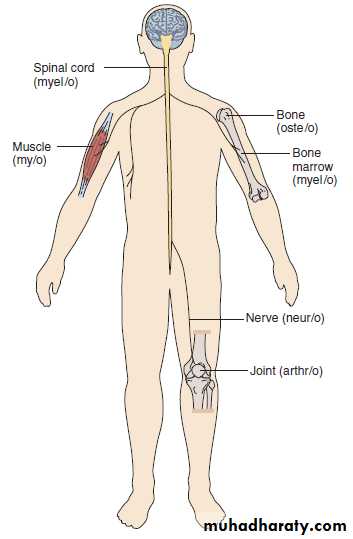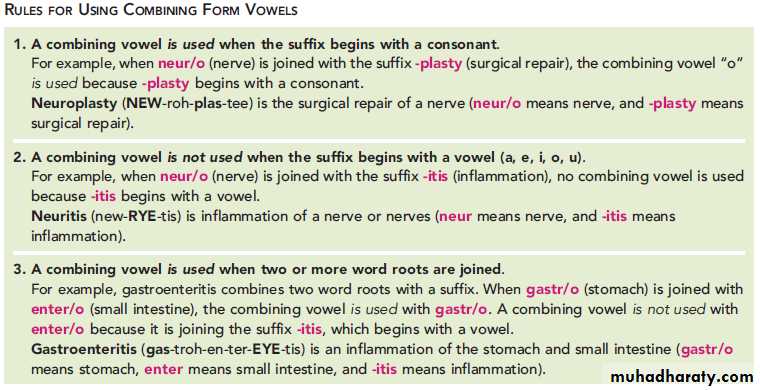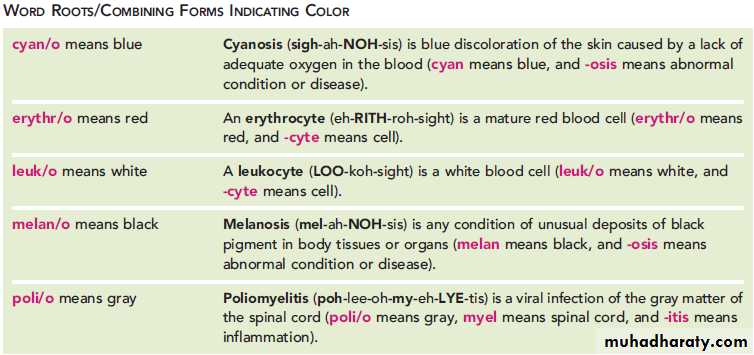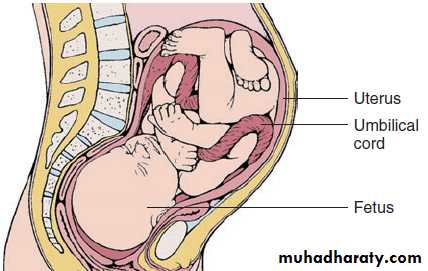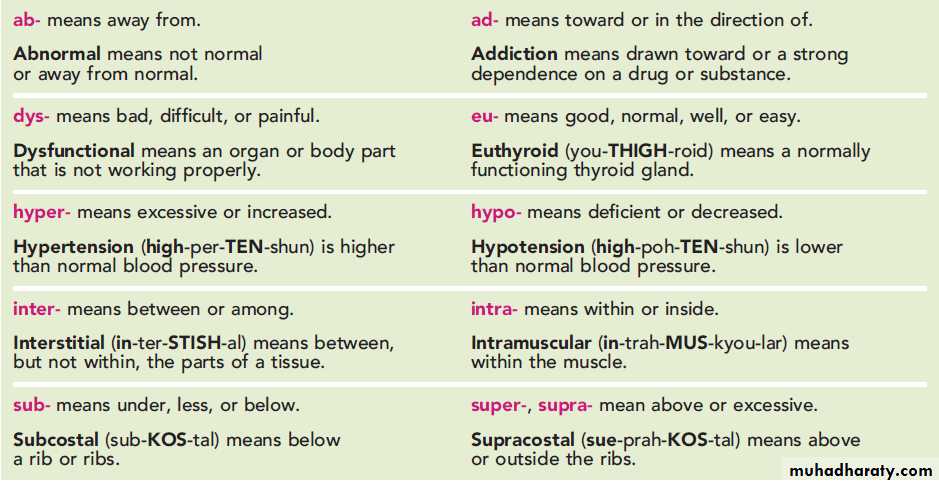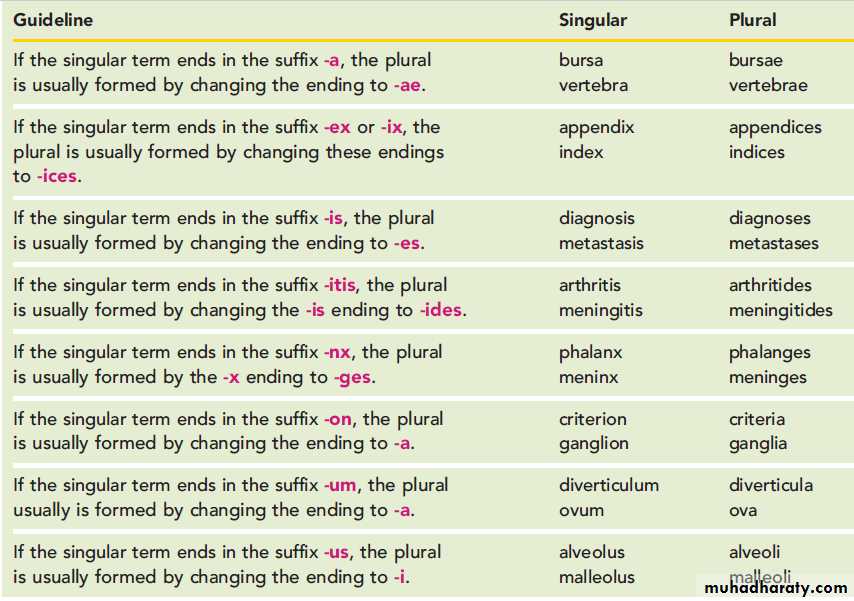Foundation of Medicine
L3-medical terminology / onlineJune 1st , 2020
Family & Community medicine dept.
Dr. Muslim N. Saeed
INTRODUCTION TO MEDICAL
TERMINOLOGYObjectives
On completion, you should be able to:1. Identify the roles of the four types of word parts used in forming medical terms.
2. Using your knowledge of word parts, analyze unfamiliar medical terms.
3. Define the commonly used prefixes, word roots, combining forms, and suffixes introduced.
5. Pronounce medical terms correctly.
6. Recognize the importance of spelling medical terms correctly.
7. State why caution is important when using abbreviations.
Introduction
Learning this special medical language is an important step in preparing for your career as a health care professional.
Learning medical terms is much easier than learning a foreign language because you are already familiar with quite a few of the words—such as appendicitis and tonsillectomy.
Understanding new words becomes easier with the discovery that many of these terms are made up of interchangeable word parts that are used in different combinations.
Once you understand this, you’ll be well on your way to translating even the most difficult medical terms, including words you have never seen before. You’ll be amazed to see how quickly your vocabulary will grow!
-Medical terminology is a vocabulary for accurately describing the human body and associated components, conditions, and processes in a science-based manner.
-Every profession has its own language(jargon) that allows for quick efficient communication between members of that profession.
-Medical terminology is a specialized language used by healthcare practitioners.
-The modern academic medicine began as a science in the days when Latin was the universal scientific language, and early medical doctors described the structures and procedures in that language.
-In medical terminology, common Latin or Greek words are used as such for any part of the body for which the ancients had a name.
-by using certain classical words or commonly, by combining Greek or Latin roots to form a new compound term.
The Four Types of Word Parts
Four types of word parts may be used to create medical terms:1. A word root
contains the basic meaning of the term. This word part usually indicates the involved body part. For example, the word root meaning stomach is gastr. A word root cannot stand alone. A suffix must be added to complete the term.
2. A combining form is a word root with a vowel at the end so that a suffix beginning with a consonant can be added. When a combining form appears alone, it is shown with a slash (/) between the word root and the combining vowel. For example, the combining form meaning stomach is gastr/o. Gastr-o-enter-itis.
3. A suffix usually, but not always, indicates the procedure, condition, disorder, or disease. A suffix always comes at the end of a word, gastr-ectomy, gastr-itis, gastr-ic.
4. A prefix usually indicates location, time, number, or status. A prefix always comes at the beginning of a word.
WORD ROOTS
Word roots act as the foundation of most medical terms.
They usually, but not always, describe the part of the body that is involved. As shown, some word roots indicate color.
Combining Form Vowels
A combining form vowel is added to the end of a
word root under certain conditions to make the
resulting medical term easier to pronounce.
-The letter “o” is the most commonly used
combining vowel.
-When a word root is shown alone as a combining
form, it includes a slash (/) and the combining vowel.
Word roots that indicate colors
SUFFIXES
A suffix is a word part that is added to the end of a word to complete that term.In medical terminology, suffixes usually, but not always, indicate a procedure, condition, disorder, or disease. For example, tonsill/o means tonsils.
The suffix that is added completes the term and tells what is happening to the tonsils.
-Tonsillitis (ton-sih-LYE-tis) is
an inflammation of the tonsils
(tonsill means tonsils,
and -itis means inflammation).
-A tonsillectomy (ton-sih-LECK-toh-mee) is the surgical removal of the tonsils (tonsill means tonsils, and -ectomy means surgical removal).
Suffixes as Noun Endings
A noun is a word that is the name of a person, place, or thing. In medical terminology, some suffixes change the word root into a noun. For example, the cranium (KRAY-nee-um) is the portion of the skull that encloses the brain (crani means skull, and -um is a noun ending). Other suffixes complete the term by changing the word root into a noun.Suffixes Meaning “Pertaining To”
An adjective is a word that defines or describes a thing.In medical terminology, many suffixes meaning “pertaining to” change the word root into an adjective. For example, the term cardiac is an adjective that means pertaining to the heart (cardi means heart, and –ac means pertaining to).
Suffixes Meaning Abnormal Condition
In medical terminology, many suffixes, such as -osis, mean “abnormal condition or disease.” For example, gastrosis (gas-TROH-sis) means any disease of the stomach (gastr means stomach, and -osis means abnormal condition or disease).
Suffixes Related to Pathology
Pathology (pah-THOL-oh-jee) is the study of all aspects of diseases (path means disease, and -ology means study of).Suffixes related to pathology describe specific disease conditions.
* -algia means pain and suffering. Gastralgia (gas-TRALjee-ah), also known as stomach ache, means pain in the stomach (gastr means stomach, and -algia means pain).
* -dynia also means pain. Gastrodynia (gas-troh-DINee-ah) also means pain in the stomach (gastr/o means stomach, and -dynia means pain). Although -dynia has the same meaning as -algia, it is not used as commonly.
The term tonsillitis is created by adding the suffix -itis to the word root tonsill.
More examples
* -itis means inflammation. Gastritis (gas-TRY-tis) is an inflammation of the stomach (gastr means stomach, and -itis means inflammation).* -malacia means abnormal softening. Arteriomalacia (ar-tee-ree-oh-mah-LAY-shee-ah) is the abnormal softening of the walls of an artery or arteries (arteri/o means artery, and -malacia means abnormal softening).Notice that -malacia is the opposite of -sclerosis.
* -megaly means enlargement. Hepatomegaly (hep-ahtoh-MEG-ah-lee) is abnormal enlargement of the liver (hepat/o means liver, and -megaly means enlargement).
* -necrosis means tissue death. Arterionecrosis (ar-teeree-oh-neh-KROH-sis) is the tissue death of an artery or arteries (arteri/o means artery, and –necrosis means tissue death).
More examples
* -sclerosis means abnormal hardening. Arteriosclerosis (ar-tee-ree-oh-skleh-ROH-sis) is the abnormal hardening of the walls of an artery or arteries (arteri/o means artery, and -sclerosis means abnormal hardening).
*Notice that -sclerosis is the opposite of -malacia.
* -stenosis means abnormal narrowing. Arteriostenosis (ar-tee–ree-oh-steh-NOH-sis) is the abnormal narrowing of an artery or arteries (arteri/o means artery, and -stenosis means abnormal narrowing.)
Suffixes Related to Procedures
*Some suffixes identify the procedure that is performed on the body part identified by the word root.* -centesis is a surgical puncture to remove fluid for diagnostic purposes or to remove excess fluid.
* Abdominocentesis (ab-dom-ih-noh-sen-TEE-sis) is the surgical puncture of the abdominal cavity to remove fluid (abdomin/o means abdomen, and –centesis means a surgical puncture to remove fluid).
* -graphy means the process of producing a picture or record. Angiography (an-jee-OG-rah-fee) is the process of producing a radiographic (x-ray) study of the blood vessels after the injection of a contrast medium to make these blood vessels visible (angi/o means blood vessel, and -graphy means the process of recording).
* -gram means a picture or record. An angiogram (AN-jee-oh-gram) is the film produced by angiography (angi/o means blood vessel, and -gram means a picture or record).
* -plasty means surgical repair. Myoplasty (MY-oh-plastee) is the surgical repair of a muscle (myo means muscle, and -plasty means surgical repair).
* -scopy means visual examination. Arthroscopy (ar-THROS-koh-pee) is the visual examination of the internal structure of a joint (arthr/o means joint, and -scopy means visual examination).
The “Double R” Suffixes
Suffixes beginning with two “Rs,” which are often referred to as the “double RRs,” can be particularly confusing. They are grouped together here to help you understand the word parts and to remember the differences.* -rrhage and -rrhagia mean bleeding; however, they are most often used to describe sudden, severe bleeding. A hemorrhage (HEM-or-idj) is the loss of a large amount of blood in a short time (hem/o means blood, and -rrhage means bursting forth of blood).
* -rrhaphy means surgical suturing to close a wound and includes the use of sutures, staples, or surgical glue. Myorrhaphy (my-OR-ah-fee) is the surgical suturing of a muscle wound (my/o means muscle, and –rrhaphy means surgical suturing).
* -rrhea means flow or discharge and refers to the flow of most body fluids. Diarrhea (dye-ah-REE-ah) is the frequent flow of loose or watery stools (dia- means through, and -rrhea means flow or discharge).
PREFIXES
A prefix is added to the beginning of a word to influence the meaning of that term. Prefixes usually, but not always, indicate location, time, or number. The term natal (NAY-tal) means pertaining to birth (nat means birth, and -al means pertaining to). The following examples show how prefixes change the meaning of this term
* Prenatal (pre-NAY-tal) means the time and events before birth (pre- means before, nat means birth, and -al means pertaining to).
* Perinatal (pehr-ih-NAY-tal) refers to the time and events surrounding birth (peri- means surrounding, nat means birth, and -al means pertaining to). This is the time just before, during, and just after birth.
* Postnatal (pohst-NAY-tal) refers to the time and events after birth (post- means after, nat means birth, and –al means pertaining to).
Contrasting and Confusing Prefixes Some prefixes are confusing because they are similar in spelling, but opposite in meaning.
DETERMINING MEANINGS ON THE BASIS OF WORD PARTS
Knowing the meaning of the word parts often makes it possible to figure out the definition of an unfamiliar medical term.Taking Terms Apart
1.To determine a word’s meaning by looking at the component pieces, you must first separate it into word parts.
2.Always start at the end of the word, with the suffix, and work toward the beginning.
3.As you separate the word parts, identify the meaning of each. Identifying the meaning of each part should give you a definition of the term.
Because some word parts have more than one meaning, it also is necessary to determine the context in which the term is being used. As used here, context means to determine which body system this term is referring to.
4.If you have any doubt, use your medical dictionary to double-check your definition.
5.Be aware that not all medical terms are made up of word parts.
An example:
Look at the term Otorhinolaryngology (oh-toh-rye-nohlar-in-GOL-oh-jee).
It is made up of two combining forms, a word root, and a suffix. This is how it looks when the word parts have been separated by working from the end to the beginning.
1.The suffix -ology means the study of.
2.The word root laryng means larynx and throat. The combining vowel is not used here because the word root is joining a suffix that begins with a vowel.
3.The combining form rhin/o means nose. The combining vowel is used here because the word root rhin is joining another word root.

